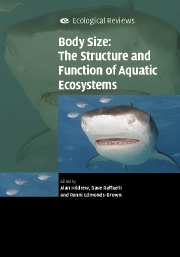Book contents
- Frontmatter
- Contents
- List of contributors
- Preface
- 1 The metabolic theory of ecology and the role of body size in marine and freshwater ecosystems
- 2 Body size and suspension feeding
- 3 Life histories and body size
- 4 Relationship between biomass turnover and body size for stream communities
- 5 Body size in streams: macroinvertebrate community size composition along natural and human-induced environmental gradients
- 6 Body size and predatory interactions in freshwaters: scaling from individuals to communities
- 7 Body size and trophic cascades in lakes
- 8 Body size and scale invariance: multifractals in invertebrate communities
- 9 Body size and biogeography
- 10 By wind, wings or water: body size, dispersal and range size in aquatic invertebrates
- 11 Body size and diversity in marine systems
- 12 Interplay between individual growth and population feedbacks shapes body-size distributions
- 13 The consequences of body size in model microbial ecosystems
- 14 Body size, exploitation and conservation of marine organisms
- 15 How body size mediates the role of animals in nutrient cycling in aquatic ecosystems
- 16 Body sizes in food chains of animal predators and parasites
- 17 Body size in aquatic ecology: important, but not the whole story
- Index
- References
10 - By wind, wings or water: body size, dispersal and range size in aquatic invertebrates
Published online by Cambridge University Press: 02 December 2009
- Frontmatter
- Contents
- List of contributors
- Preface
- 1 The metabolic theory of ecology and the role of body size in marine and freshwater ecosystems
- 2 Body size and suspension feeding
- 3 Life histories and body size
- 4 Relationship between biomass turnover and body size for stream communities
- 5 Body size in streams: macroinvertebrate community size composition along natural and human-induced environmental gradients
- 6 Body size and predatory interactions in freshwaters: scaling from individuals to communities
- 7 Body size and trophic cascades in lakes
- 8 Body size and scale invariance: multifractals in invertebrate communities
- 9 Body size and biogeography
- 10 By wind, wings or water: body size, dispersal and range size in aquatic invertebrates
- 11 Body size and diversity in marine systems
- 12 Interplay between individual growth and population feedbacks shapes body-size distributions
- 13 The consequences of body size in model microbial ecosystems
- 14 Body size, exploitation and conservation of marine organisms
- 15 How body size mediates the role of animals in nutrient cycling in aquatic ecosystems
- 16 Body sizes in food chains of animal predators and parasites
- 17 Body size in aquatic ecology: important, but not the whole story
- Index
- References
Summary
Introduction
The past 15 years have seen a dramatic increase in the study of large-scale patterns and processes in ecology under the banner of macroecology (Brown & Maurer, 1989). Organismal body size is one of the key components of many of these studies, and the distribution of body size and its relationship with range size and abundance figure extensively in the macroecological literature (Gaston & Blackburn, 2000; Blackburn & Gaston, 2003; Gaston, 2003). Body size is also the central component of the ‘three-quarters scaling law’, which predicts that metabolism scales to body mass0.75 (e.g. Gillooly et al., 2001) and is seeing increasing use in ecological predictions, including those concerning trophic interactions (Woodward et al., 2005), population dynamics (Marquet et al., 2005), species diversity (Allen, Brown & Gillooly, 2002) and energy flow (Enquist et al., 2003); indeed, the scaling of metabolism with body mass has also recently been used in attempts to make macroecological predictions (e.g. Jetz et al., 2004).
Despite the recent surge of interest in large-scale ecological patterns, aquatic ecologists have been slow to take up the concept of macroecology. It could perhaps be argued that much of the aquatic ‘community ecology’ over the past couple of decades, relating assemblage composition in aquatic systems to environmental variables, was macroecology of sorts. However, this research has rarely progressed to examine over-arching patterns and their potential underlying mechanisms, and is therefore somewhat limited in how it can inform general ecological theory.
- Type
- Chapter
- Information
- Body Size: The Structure and Function of Aquatic Ecosystems , pp. 186 - 209Publisher: Cambridge University PressPrint publication year: 2007
References
- 33
- Cited by



